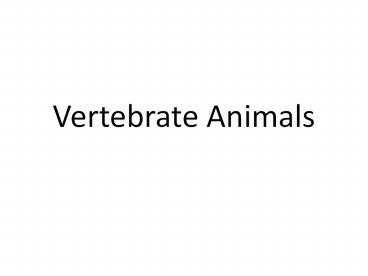Vertebrate Animals - PowerPoint PPT Presentation
Title: Vertebrate Animals
1
Vertebrate Animals
2
I- Phylum Chordata
- A) 3 basic characteristics
- 1) presence of a notochord
- a) flexible, rod-like structure
- b) replaced by backbone in adults
- 2) presence of dorsal nerve cord
- a) hollow tube
- b) becomes brain and spinal cord
- 3) presence of gill slits (at some point)
- a) passage of water/oxygen
3
(No Transcript)
4
- B) 5 major classes
- 1) fish
- 2) amphibians
- 3) reptiles
- 4) birds
- 5) mammals
5
- II) Fish
- A) Agnatha jawless fish
- 1) suction mouth
- 2) notochord remains
- a)lack bony skeleton ? cartilage
- 3) ex. lamprey and hagfish
6
- B) Chondrichthyes cartilage fish
- 1) moveable jaw
- 2) skeleton made of cartilage
- 3) scales
- 4) ex. sharks and rays
7
- C) Osteichthyes bony fish
- 1) skeleton made of bone
- 2) presence of a swim bladder
- 3) ex. tuna, trout, salmon, goldfish
8
- D) general characteristics
- 1) ectotherms (cant regulate body temperature)
- 2) gills used for respiration
- 3) body covered in scales
- 4) fins aid in movement
- 5) digestion, respiration, circulatory,
- excretory, nervous and reproductive
systems
9
10
- III) Amphibians
- A) evolution of the tetrapod
- 1) fins develop into limbs
11
- B) 3 classes
- 1) frogs
- 2) toads
- 3) salamanders
12
(No Transcript)
13
- C) live a portion of life cycle in water
- 1) reproduction (external fertilisation)
- 2) metamorphosis
14
(No Transcript)
15
- D) life on land
- 1) lungs
- 2) moist, smooth skin for gas exchange
- a) risk of drying out
- b) gravely affected by pollution
- 3) ectothermic
16
- IV) Reptiles
- A) 4 major groups
- 1) lizards
- 2) snakes
- 3) turtles
- 4) crocodilians
17
(No Transcript)
18
- B) fully adapted to life on land
- 1) scales (prevent dehydration)
- 2) lungs for gas exchange
- 3) limbs point downward, with claws
19
- 4) ectothermic (basking)
- 5) internal fertilisation
- 6) development of egg with a shell
- a) amniotic egg
20
- V) Birds
- 1) 2 legs 2 wings
- a) scales claws on leg
21
- 2) body covered in feathers
- a) made of keratin (like scales of
reptiles) - b) hollow tube light weight
- c) several functions
- i) warmth (down feathers)
- ii) coloration
- iii) flight (several adaptations)
- d) molting
22
(No Transcript)
23
(No Transcript)
24
(No Transcript)
25
- 3) skeleton made of hollow bones
26
- 4) toothless beak
- a) several different shapes
27
- 5) eyes on either side of head
- a) some birds an exception (ex. owls)
- 6) more vertebrae on neck than other vertebrates
- a) can turn head 180
28
- 7) endothermic
- a) can regulate body temperature
- i) 45C
- 8) internal fertilisation
- a) amniotic egg
- b) mother/father cares for young
29
- 9) 4 chambered heart
30
(No Transcript)
31
- VI) Mammals
- A)characteristics
- 1)highly developed brain
- a) large cerebrum
- b) convolutions
32
(No Transcript)
33
- 2) endothermic
- 3) breathe using diaphragm
- 4) hair
- a) blubber in aquatic mammals
- i) more stream-lined
34
(No Transcript)
35
(No Transcript)
36
- 5) 4 types of glands
- a) sweat glands (regulate body temp.)
- b) sebaceous glands (lubricate hair, skin)
- c) scent glands (communication)
- d) mammary glands (nourish young)
- 6) highly developed teeth
- a) diverse diets (herbivores, carnivores,
- omnivores)
37
(No Transcript)
38
(No Transcript)
39
- 7) internal fertilisation
- a) young develops in uterus
- i) mother/father cares for young
40
- 8) 4 chambered heart
- B) 3 mammal groups
- 1) monotremes (ex. duck-billed platypus,
echidna) - a) lay eggs
- b) milk from sweat glands
41
- 2) marsupials
- a) original development in uterus
- b) further development in pouch
- c) milk from mammary glands
42
- 3) placental mammals
- a) long gestation period
- i) remain in uterus until highly
developed - ii) placenta nourishes young through
umbilical cord - b) young nourished with milk
43
(No Transcript)































